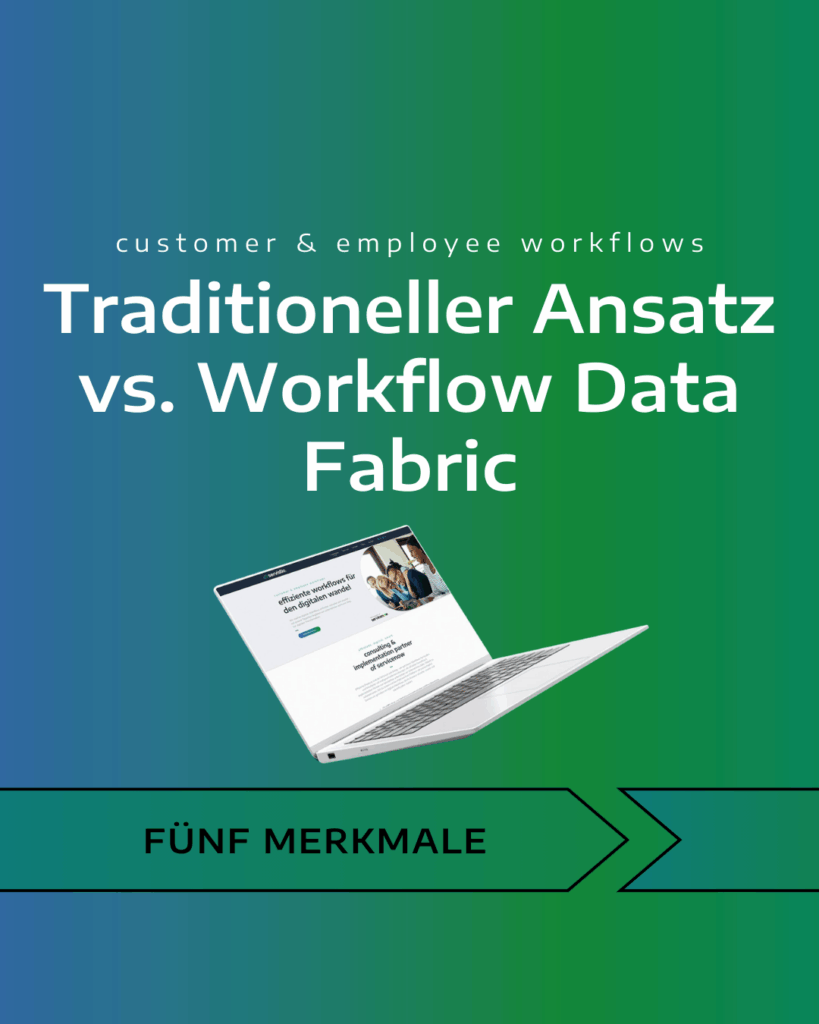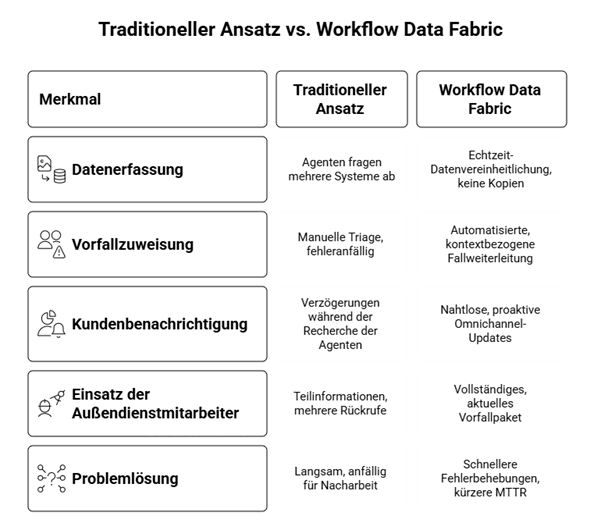Introduction:
Digital workflows form the backbone of operational efficiency in modern companies. However, increasing system diversity and data fragmentation present companies with a challenge: how can distributed data be retrieved and processed in real time and without complex integrations or duplication? ServiceNow Workflow Data Fabric helps solve this problem.
Workflow Data Fabric is an advanced integrated data layer that unifies business and technology data across the enterprise and provides all workflows and AI agents with secure, real-time access to data from any source. The use of zero-copy connectors optimizes integration capabilities, allowing customers to instantly turn data into AI-powered actions. Workflow Data Fabric extends organizations’ ability to connect, understand and process structured, unstructured, semi-structured and streaming data across the enterprise – both inside and outside of ServiceNow – for maximum scalability and efficiency.

Important functions of ServiceNow Workflow Data Fabric:
- Unified data access with zero-copy architecture: Zero-copy connectors keep the data at its original source (e.g. Snowflake, Databricks, ERP, CRM, etc.) and make it immediately available when needed.
- There are two types of zero-copy connectors available:
Primary connectors – created and supported by ServiceNow (e.g. Databricks, Snowflake, Google BigQuey , Oracle, Amazon Redshift)
Community connectors – open source, certified but not officially supported (e.g. PostgreSQL, MongoDB, Apache Cassandra, Hive, Delta Lake, Exasol , Microsoft SQL Server, OpenText Analytics Database, SingleStore)
- High-performance data processing: Supports real-time event streaming through integration with Kafka and native streaming connectors.
Mithilfe von RaptorDB Pro erreicht ServiceNow:
- Bis zu 53 % schnellere Transaktionsverarbeitung*
- 27-mal schnellere Analysen und Berichte*
- 3x höherer Workflow-Durchsatz*
*Source – www.servicenow.com
- Extensive integration hub and connectors:
- Over 500 pre-built connectors and APIs enable quick integration with enterprise platforms such as SAP, Salesforce, Microsoft 365, Atlassian Confluence, Box and more.
- Semantic level and knowledge graph
- Provides contextualization of raw data by linking people, processes and systems.
- AI-enabled and automation-capable: Provides AI-supported virtual agents and GenAI models with precise real-time data.
- Integration with Robotic Process Automation (RPA) enables the automation of tasks even without APIs.
- Process mining tools visualize inefficiencies in the workflow and enable continuous improvement by monitoring KPIs and ROI.
- Enterprise-level security and governance
- Centralized policy controls enforce role-based access, audit logging and anomaly detection.
- Supports regulatory compliance by securing confidential information and controlling user actions on data.
For example, how do telecommunication companies benefit from Workflow Data Fabric:
Problem:
Telecommunications companies face major hurdles in providing exceptional customer service for the following reasons:
- Fragmented data: Customer information is often scattered across CRM, billing, network monitoring and support ticketing systems.
- Slow issue resolution: Agents lack real-time visibility into a customer’s entire journey, resulting in longer wait times and frequent handoffs.
- Manual processes: Customer issues such as outages or service requests are manually routed, leading to further delays and errors.
- Customer frustration: Disjointed experiences lead to low satisfaction and poor Net Promoter Scores (NPS).
Solution:
ServiceNow’s Workflow Data Fabric helps solve the complexities caused by data fragmentation.
Connect and contextualize data:
Connects customer records, ticket history, network events and device inventory directly from their original sources, without duplication or migration. This gives agents a unified, real-time view as soon as a customer interacts with support.
A data manager uses Workflow Data Fabric to establish a live, unprotected connection to the data source environment. This is done by adding connection details and a private key. Important external tables, such as customer data from the CRM source, are then mapped to Data Fabric tables in ServiceNow. This mapping creates a virtual representation of the external data.
The data itself is not retained in ServiceNow, but is queried in real time when accessed. This approach eliminates unnecessary data duplication and improves security, compliance and cost efficiency. Unlike remote tables, Zero-Copy Connectors process millions of records and provide direct, out-of-the-box functionality without custom scripting.

Integrated customer service workflows
Automated case routing: Cases – network outages, billing issues or service upgrades – are intelligently assigned to the right teams or agents, taking into account customer value, previous issues and network status in real time.
Predictive problem resolution: AI agents proactively detect anomalies (such as repeated dropped calls or slow broadband speeds) and automatically trigger remediation workflows, sometimes even before the customer calls.
Knowledge graph: Connects people, products, locations and incident histories, enabling agents and virtual assistants to provide personalized, contextual responses.
Real-time alerts and AI-driven actions:
Integrates streaming network data and customer alerts, providing immediate context on outages or service degradations affecting specific customers or regions.
Faster resolution and improved customer experience
Faster repair time: Field technicians get consolidated, context-rich incident data with just one click, enabling them to resolve issues quickly. Some telcos report up to 97% faster repair time compared to traditional methods.
Continuous improvement: ServiceNow’s process mining tools uncover bottlenecks and enable workflow improvements based on actual results.
Below is a diagram illustrating the comparison between the traditional troubleshooting method and the Workflow Data Fabric method of visualizing data for real-world issues.

Final thoughts:
ServiceNow Workflow Data Fabric is more than just a technical feature – it’s a strategic enabler for organizations that want to be agile, data-driven and uncompromisingly integrated. By abstracting away complexity and enabling real-time decision making, it helps organizations act faster and smarter in a world that demands both. Do you have many fragmented data sources that make a good customer experience difficult and can be improved with Workflow Data Fabric?
